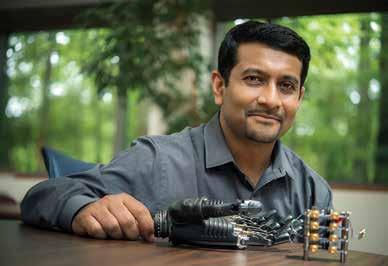
3 minute read
Adapting to Remote Research
George Mason University suspended almost all research activities conducted in its labs and facilities amid the coronavirus pandemic, but Mason Engineering researchers found ways to continue their work remotely. Many did computer-based work, conducted portions of studies at home, and wrote papers about results.
Bioengineering professor Siddhartha Sikdar continued his research on controlling prostheses using ultrasound waves. Photo by Evan Cantwell USING ULTRASOUND TECHNOLOGY TO OPERATE PROSTHESES Bioengineering professor Siddhartha Sikdar is using technology to help individuals with limb loss better control their prostheses. His team is investigating a new way to operate prostheses using ultrasound waves to sense muscle activity. The research group was recently awarded a Bioengineering Research Partnership grant from the National Institutes of Health (NIH) to develop this technology for commercial use and perform clinical trials in subjects. The project was just ramping up when the lab had to close. However, the team developed plans to continue making progress remotely. “Our NIH grant has a strict schedule of milestones, but we were able to reprioritize some of the tasks that were more focused on software development, which could be done remotely,” Sikdar says. The group also continued some portions of testing and evaluation tasks remotely. His graduate students built temporary workstations at home with equipment from the lab to continue testing prototypes. The students and trainees also worked on analyzing data that had been collected and continued working on journal papers.
LAYING THE FOUNDATION TO DEVELOP VACCINES Remi Veneziano, an assistant professor in the Department of Bioengineering, is using DNA nanotechnology to lay the foundation for developing vaccines that could fight viruses such as the coronavirus.
While his lab was closed, some graduate students used software that allows 3D designs and renderings to explore new DNA nanoparticle architectures. These can be used for vaccine platform development and other biomedical applications, Veneziano says. “It’s a safe and elegant way to design vaccines,” he says. “If successful, our strategy could be adapted for emerging viruses and applied to several other pathogens, including the coronavirus.”

Remi Veneziano, an assistant professor in the Department of Bioengineering, and his research team are laying the foundation for developing vaccines that could fight viruses such as the coronavirus. Photo by Ron Aira.
Max Albanese, an associate professor in the Department of Information Sciences and Technology, continued to do cybersecurity research when the labs closed. Photo by Creative Services DEFENDING AGAINST CYBER ATTACKS Massimiliano (Max) Albanese, a Mason Engineering cybersecurity researcher, has spent years studying the minds and methods of cyber criminals to develop better ways to defend computer systems. He did advance legwork to continue his research. “I systematically stored every file or dataset I needed in a cloudbased repository, so I was able to transition to remote work without having to move any data from my office computer,” says Albanese, an associate professor in the Department of Information Sciences and Technology. As associate director of the Center for Secure Information Systems, he’s working with researchers at other institutions to develop adaptive defenses against cyberattacks as part of a six-year, $6.75 million grant from the U.S. Department of Defense.
“As cybersecurity researchers, we are fortunate because the resources we need for our research and to run experiments can be accessed remotely. [That] is critical to efficiently and effectively move operations online in a situation like the one we are experiencing today,” he says.
GAINING INSIGHTS FROM ONLINE LEARNING Jill Nelson, an associate professor in the Department of Electrical and Computer Engineering, continued her research in two diverse areas.
She’s studying algorithms for making intelligent decisions about how to allocate resources in active sonar surveillance systems, as well as how communities of instructors, graduate teaching assistants, and undergraduate learning assistants can promote activelearning practices in entry-level college STEM courses, including calculus and physics. For the latter study, Mason’s recent switch to virtual learning could provide Nelson’s group with new data. “We’ll now be able to examine some interesting questions about those courses now that they’re online,” she says.
—Nanci Hellmich Jill Nelson, an associate professor in the Department of Electrical and Computer Engineering, will use data from Mason’s recent switch to virtual learning for one of her research projects. Photo provided











